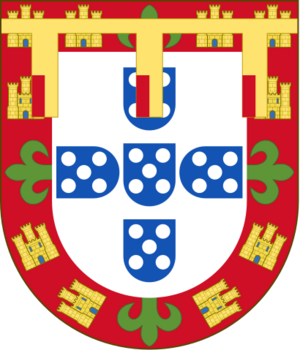John, Constable of Portugal facts for kids
Quick facts for kids Infante John |
|
|---|---|
| Constable of Portugal Lord of Reguengos de Monsaraz, Colares and Belas |
|

Detail from the St. Vincent Panels by Nuno Gonçalves, often believed to be a portrait of John of Reguengos, the Constable Prince.
|
|
| Born | 13 January 1400 Santarém, Portugal |
| Died | 18 October 1442 (aged 42) Alcácer do Sal, Portugal |
| Burial | Batalha Monastery |
| Spouse |
Isabella of Barcelos
(m. 1424) |
| Issue Detail |
|
| House | Aviz |
| Father | John I of Portugal |
| Mother | Philippa of Lancaster |
Infante John, Constable of Portugal (born January 13, 1400 – died October 18, 1442) was a Portuguese prince. In Portugal, he was often called O Infante Condestável, which means "the Constable Prince." He was an important member of the House of Aviz, a royal family in Portugal. He held the title of Constable of Portugal, which was a very high military position. He was also the leader of the Order of St. James, a special group of knights.
Contents
Prince John's Early Life
Prince John was the son of King John I of Portugal and his wife Philippa of Lancaster. He had several brothers and a sister. These included Edward, Peter, Henry, Ferdinand, and Isabella. His half-brother was Afonso. Historians often call John and his siblings the 'illustrious generation' because they were all very important in Portugal's history.
Prince John's Important Roles
Prince John was given control of several lands, including Reguengos de Monsaraz, Colares, and Belas. In 1418, the Pope agreed to make Prince John the 10th Master of the Order of St. James of the Sword. This meant the royal family now had control over this old military order.
That same year, John and his brother Henry the Navigator led a fleet of ships. They went to Ceuta, a city in North Africa, to help lift a siege. Their efforts helped protect the city.
In 1431, a famous military leader named Nuno Álvares Pereira passed away. Prince John was then chosen to be the 3rd Constable of Portugal. This was a very powerful military role, which is why he was known as "the Constable Prince."
After his father, King John I, died in 1433, John's oldest brother became King Edward of Portugal. In 1437, Prince John and his brother Peter, Duke of Coimbra disagreed with a plan to attack Tangier. This attack, known as the Battle of Tangier, ended badly for Portugal.
After this failure, John wanted Portugal to make a deal with Morocco. The deal would have meant giving up Ceuta to get his captive brother, Ferdinand the Holy Prince, back. However, the Portuguese parliament (called the Cortes) said no. Sadly, Ferdinand remained a prisoner and later died.
A Time of Change in Portugal
King Edward died in September 1438. His young son, Afonso V of Portugal, became king. However, Afonso was too young to rule, so his mother, Eleanor of Aragon, became regent. A regent rules for a king or queen who is too young or unable to rule.
Many people in Portugal did not like this arrangement. They worried that Queen Eleanor would be controlled by powerful nobles. These nobles wanted to get back the special rights they had lost years ago. To prevent a civil war, Prince John quickly took control of Lisbon. He then helped gather the Cortes, which chose his brother Peter of Coimbra to be the regent for young King Afonso V.
The powerful nobles, led by John's half-brother Afonso of Barcelos, wanted Eleanor to stay in power. Eventually, Peter and Eleanor agreed to share the regency.
Prince John worked closely with his brother Peter. This alliance helped Peter have most of the power during the first few years of the regency. Prince John's sudden death in October 1442 was a big loss for Peter. After John died, Peter found it much harder to keep control against his half-brother Afonso.
Regent Peter chose John's son, Diogo of Portugal, to take over his father's roles. Diogo became the Master of the Order of Santiago and Constable of Portugal.
Family Life
In 1424, Prince John married Isabella of Barcelos. She was the daughter of his half-brother, Afonso of Barcelos. John and Isabella had four children:
- Infante Diogo of Portugal (1425–1443) – He became the 4th Constable of Portugal and 11th Master of the Order of St. James. He did not have any children.
- Infanta Isabella of Portugal (1428–1496) – She married John II of Castile and became the mother of Isabella I of Castile, a very famous queen.
- Infanta Beatrice of Portugal (1430–1506) – She married Infante Ferdinand, Duke of Viseu and was the mother of Manuel I of Portugal, who later became king.
- Infanta Phillipa of Portugal (1432–1444) – She was known as the Lady of Almada.



